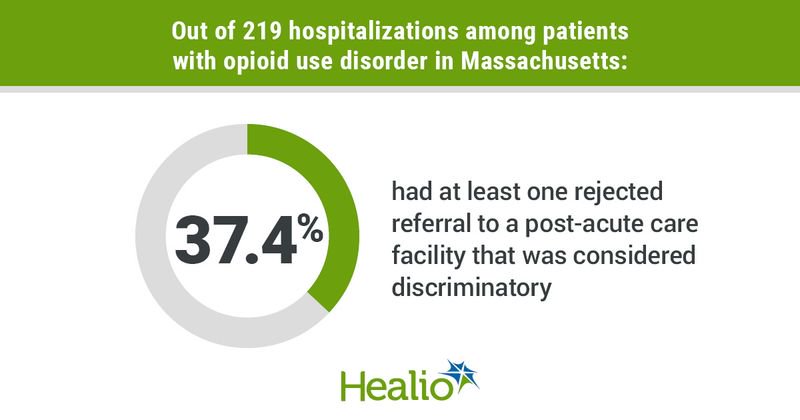Patients with opioid use disorder face discrimination in post-acute care
Many patients with opioid use disorder referred to post-acute care in Massachusetts were rejected due to a substance use disorder diagnosis or because they were treated with buprenorphine or methadone, according to a study published in the Journal of Addiction Medicine.
“We found that people with opioid use disorder who required ongoing medical or nursing care, physical therapy, and other services after an acute hospitalization were systematically excluded from this care through discriminatory practices in violation of state and federal policies,” Simeon D. Kimmel, MD, MA, assistant professor of medicine at Boston University School of Medicine, told Healio Primary Care.

In 2016, the Massachusetts Department of Public Health issued guidance for the state’s post-acute medical facilities that patients who received opioid agonist therapy (OAT) but were otherwise eligible for admission to the facility should not be rejected because of these treatments.
Kimmel and colleagues sought to determine how often inpatients with opioid use disorder (OUD) were rejected when referred to post-acute care. They also examined whether there was a change in the rate of rejections following a settlement between the U.S. Attorney and a Massachusetts nursing facility in May 2018 for violating anti-discrimination laws under the Americans with Disability Act after rejecting a patient because of buprenorphine treatment.

They collected data on 2018 referrals from Boston Medical Center to private post-acute medical care facilities in Massachusetts and linked them with clinical data.
The researchers classified rejections that were made due to substance use or treatment with OAT as discriminatory.
They identified 219 hospitalizations related to OUD in 2018. These hospitalizations led to 1,648 referrals to 285 facilities, 81.8% of which were rejected.
Kimmel and colleagues determined that 37.4% of hospitalizations had at least one rejection that was considered discriminatory, and 15.1% of all rejections were discriminatory.
Of the facilities included in the study, 29.1% made at least one rejection that was discriminatory.
Kimmel and colleagues did not observe a difference in the rate of these rejections before and after the May 2018 settlement.
In addition to their legal responsibility to care for patients with OUD, Kimmel said that post-acute care centers “also have an ethical responsibility to provide equitable care for people with opioid use disorder, especially during the current opioid crisis.”
He said these facilities should partner with addiction specialists when necessary, as they do with outside specialists to care for patients with complicated cancers, cardiac and psychiatric diagnoses.
“All staff in post-acute care facilities, including physicians, should be able to care for patients with opioid use disorder,” Kimmel added. “It is a common and treatable condition.”
According to Kimmel some facilities may need more clinical and technical support in order to provide these patients with effective, evidence-based care.
He added that there is “a clear need to combat the pervasive stigma and discrimination patients with opioid use disorder face.”
Therefore, efforts are needed to “reduce barriers to caring for patients with opioid use disorder by lifting restrictions that make it more challenging for facilities to provide medications for opioid use disorder,” Kimmel said.

